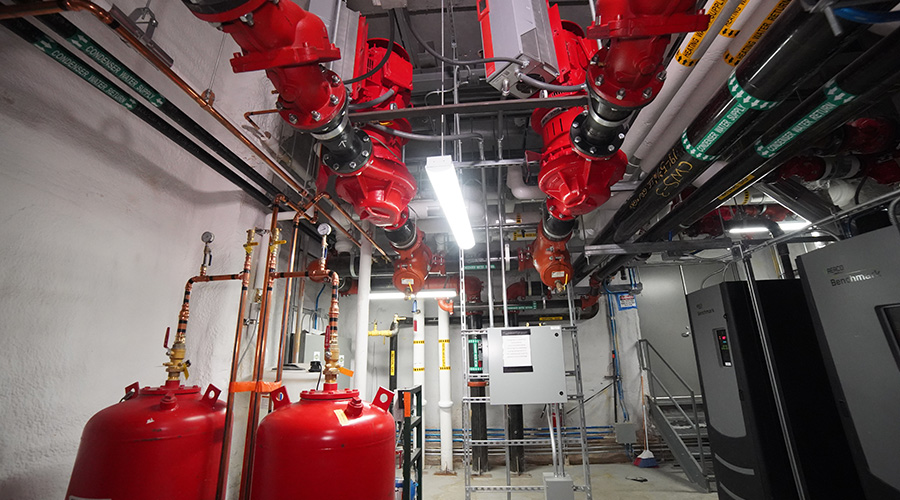A Holistic Approach to Sizing Motors
Myriad considerations — from how motors integrate with other building systems to mission demands, regulations and energy considerations — must be factored into motor decision-making
In conjunction with the National Electrical Manufacturers Association (NEMA)
Properly selected and installed, motors can operate for many years with a small amount of maintenance. But if a motor is significantly oversized for the job, it will not run at optimum performance and will not use energy efficiently. If the motor is considerably undersized for its application, the motor will not last long.
The National Electrical Manufacturers Association (NEMA) revised MG 1-2003, Motors and Generators, in July 2004. MG 1-2003 offers more than 500 pages of manufacturing and performance data for electric motors and generators.
“This revision to further align with international standards and address changes in the application of electric motors maintains the position of the NEMA MG 1 standard as the definitive standard for electric machines in North America,” says Roger Daugherty, technical committee chairman of NEMA’s motor and generator section, and consulting engineer for Rockwell Automation.
“Sizing motors for the job begins by considering such motor options as motor/drive dynamics, motor technologies and specifications,” says Kurt Riesenberg, NEMA director of industry programs. “Next, look at these elements in relation to the total building so that they are properly integrated into the building’s overall energy use strategy.”
Operational considerations that specifying maintenance and engineering managers need to consider include calculating life-cycle costs and performing value engineering. They need a quality-assurance game plan that takes into account regional regulatory and energy considerations. Finally, the motors need to be matched with the job they will do.
Integration and Monitoring
Motors operating throughout a building can be a significant factor in energy use. For instance, 3M Center’s Building 123 project reduced electricity use by 41 percent, resulting in cost savings of more than $77,000 annually with four energy-saving upgrades, including motors, according to a Best Practices study by the Office of Industrial Technologies of the U.S. Department of Energy.
An evaluation of all electric motors larger than 1.5 horsepower in the 529,000-square-foot building noted 50 older, standard-efficiency motors that operated more than 6,000 hours per year. Of these, 28 were retrofit to energy-efficient motors, with an energy improvement of 2-5 percent for each retrofit. Some of the motors underwent sheave changes to slow down the driven load. Some motors were downsized to match system requirements. Simple payback for the motors upgrades was 3.06 years.
Downsizing is one promising area for energy improvements, says Dale A. Basso, chairman of the NEMA Motor & Generator Product Section, and manager of special uses for Rockwell Automation.
“... Often, the HVAC system is sized for the hottest period ever expected, so the system’s motor gets oversized,” he says. “But buildings rarely run at this worst case, so the motor does not need to be oversized. When the HVAC system is not running at full load, the motor is running less efficiently.”
Electric motor-driven systems use 23 percent of all electricity sold in the United States, according to the CEE Motor Systems Initiative. Motor monitoring and control help ensure that motors are operating optimally.
“When ... examining your operations, make sure you look at your drive technologies,” Basso says. “The impact of variable speed drives often can significantly reduce energy use, particularly on newer HVAC applications.”
If the motor is undersized or frequently operating at more than 100 percent of its capacity, monitoring bearing temperatures might be important to extending the motor’s life, Basso says, but he adds that many times, motors are oversized for their applications.
“When the motor is oversized for the job, it has a snowball effect on first costs,” Basso says. “If you put a 125-horsepower motor on an application that needs 100 horsepower, you also have to specify a larger starter, stronger wiring and cabling, as well as sizing up your drive.”
Electric motors perform efficiently when used and maintained properly. Efficiencies vary, depending on motor load, and for constant-speed motors, efficiency decreases as the motor load decreases. Managers can increase efficiency by turning off unneeded motors and sizing motors properly. It also helps to consider operating costs, as well as the first costs associated with motor replacement.
Calculating Life-cycle Costs
When it comes to motors, life-cycling-cost calculations address the construction of motors.
“For example, a NEMA Premium™ motor may cost $1,500, which is more than a standard motor,” says Tony Hood, vice president of WEG Electric Motor Corp. “But it’s important to consider the increased energy efficiency of that motor. Over its five-year lifetime, it may save $10,000 in energy costs. A 2 percent efficiency gain will save the facility $2,000 a year, and that savings is more than the first costs of that motor ...”
Besides higher efficiencies, NEMA Premium Motors must be built with better materials and designed using “tighter” specifications.
“What that means for the facilities manager is that there often will be a lower temperature rise in that motor,” Hood says. “Lower temperature allows the motor to run cooler, which means it will last longer. So, you benefit in extended service, too.”
Value-engineering Calculations
When evaluating a machine or building with a number of motors, value engineering makes sense, says Tim Schumann, motor product manager for SEW-Eurodrive Inc.
“Basically, you begin by getting an overall view of the specific application,” Schumann says. “You look at such items as duty cycles, load demands, speed, torque issues and whether they are constant or variable, as well as other machinery requirements.”
Once those elements are addressed, motors and drives can be rated from low-end performance to high-end performance to meet those specific requirements.
“Then, based on cost and return on investment, managers can choose what’s best for their particular operation,” Schumann says.
Quality Assurance
When motor manufacturers initially pushed the efficiency envelope, they found other issues. Some early versions of energy-efficient motors had starter problems, random starter trips and locked rotors caused by the amperes that were too high, Basso says. There also were lead length and grounding considerations.
“Today, these issues have been corrected, and the problems of energy-efficient motors have faded into obscurity,” he says. “Most motors between 1 and 300 horsepower can be specified as NEMA Premium units. That specification tells the designers that they can count on the NEMA Premium characteristics.”
Matching Facility Mission Demands
To optimize motor use based on the demands of the facility, Basso recommends determining the actual load very carefully, noting the frequency and timing of any full-load demands on the motor. Then, managers can choose a motor that meets the actual needs more closely, saving on both first costs and life-cycle energy costs.
“In pump applications, for example, you really don’t need to size NEMA Premium motors for more than 90 percent of the pump’s top capacity,” Basso says. “So, a 125-horsepower pump requires a 100-horsepower motor. Maybe once a year, that motor will be required to run at 105 horsepower. But normally, the system runs at a lower flow rate. Motors today can handle a slightly higher load than their rating — when they are not running at peak load most of the time.”
The DOE Office of Industrial Technologies offers a Pumping System Assessment Tool (PSAT) that helps managers assess energy-savings opportunities in pumping systems. The software uses field measurements of flow rate, plus head and motor power or current for the assessment. Then PSAT estimates the existing pump and motor efficiency and calculates the potential energy and cost savings if the system is optimized.
For fan motors, DOE is partnering with the Air Movement and Control Association to develop a Fan System Assessment Tool (FSAT), which is expected to perform similarly.
While many motor applications can use general-purpose motors, some applications demand motors designed for a specific purpose. For example, cooling towers and some compressors often need specialized motors, says Mike Logsdon, engineering manager for the Motor Technologies Group for Regal-Beloit Corp.
“Customers also may have specific needs, so manufacturers customize the motor to meet their specific application, the environment they are operating and so on,” Logsdon says. “Maybe they need a motor that is particularly resistive to dust, and so it needs a special enclosure.”
There also might be electrical requirements that such specialized motors need to meet. Most general-purpose motors use NEMA Design B. Design C specialty motors have higher torques. “Design D is extremely high torque,” Logsdon says. “Design A is similar to Design B, except it allows the starting current to go higher, which is particularly useful with variable-frequency drives, since the drive limits the starting current.
Measuring Motor Performance
To measure performance, motors undergo a dynamometer load test per NEMA MG-1 Part 12 and IEEE Standard 112 Method B.
“This testing is in addition to the routine electrical tests performed on every motor during manufacturing,” says Tim Marker, manager, industrial motors engineering for GE Consumer and Industrial. “It allows verification of the actual motor load, winding temperature, speed, efficiency, power factor, input current, input power, locked rotor current, locked rotor torque and breakdown torque at various load points between 25 percent and 125 percent of rated load.”
Using Method B generally is considered a better test method than using Method A. Method A measures the input power minus the output power to determine motor efficiency. Method B measures the various losses, including rotor core, stator core, windage and friction, and stray load losses.
Efficiency Benchmarks
To benchmark efficiency levels for motors, there are several groups that have defined test methods, notably the Energy Policy Act (EPAct), CSA C390 and the NEMA Premium efficiency specification.
“EPAct defines the minimum, nominal full-load efficiencies required on all definite-purpose motors between one horsepower and 200 horsepower in two-, four- and six-pole ratings and specifies IEEE Standard 112 method B as the test method for verifying the nominal efficiencies,” Marker says. “EPAct also requires that motor efficiencies be certified through NVLAP- (National Voluntary Accreditation Program) certified labs. NVLAP certification includes the circulation of some motors to all NVLAP labs to ensure that there are no significant deviations in the test results from lab to lab.”
Until NEMA defined standards for motors, every major motor manufacturer offered, standard, EPAct-efficient and Premium motors.
“The problem was, we all called our highest performing motors by different marketing buzzwords, with no meaning or standard behind them,” Hood says. “Maybe our motor was 96 percent efficient, and Brand X was 95 percent efficient. But we both might be calling that level in our product line, the premium level. Now, premium is an industry term and companies claiming NEMA Premium motors have to meet that standard.”
NEMA is the leading trade association in the United States representing the interests of electroindustry manufacturers. Founded in 1926 and headquartered near Washington, D.C., its 400-member companies manufacture products used in the generation, transmission and distribution, control, and end-use of electricity. Domestic shipments of electrical products within the National Electrical Manufacturers Association (NEMA) scope exceed $100 billion. The NEMA Motor & Generator Section administers the NEMA Premium™ program and licensing, as well as various technical , policy, data and standardization efforts for the industry.
Related Topics:











